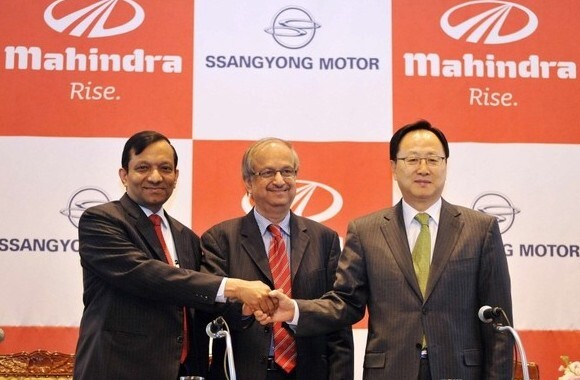hankyoreh
Links to other country sites 다른 나라 사이트 링크
Mahindra says no direct investment will be made in Ssangyong Motor

By Kim Kyung-rok, staff reporter
“There will be no direct investment in Ssangyong Motors.”
Mahindra Group, the main shareholder in Ssangyong Motors, expressed a firm position concerning investment in Ssangyong Motor, which it had refrained from doing. On Feb. 14, Mahindra, an Indian multinational auto manufacturer, held a board of directors meeting where the Indian company approved a plan to issue stocks to raise 80 billion won (US$74.19 million) in capital. The following day, the group made it clear that it has no plans to provide additional direct investment.
“Ssangyong Motor and Mahindra are planning to develop three new cars and six engines within the next four years, which will require around 1 trillion won (US$927.39 million),” Pawan Goenka, president of the automotive and farm equipment divisions for Mahindra, said in an interview with some reporters on Feb. 15. “Aside from the 80 billion won, it is the position of our headquarters in India that Ssangyong must come up with additional funding on its own.”
During a hearing about Ssangyong Motor at the National Assembly in Seoul in Oct. 2012, Mahindra Group said multiple times that 1 trillion won would be invested by 2016, but it never made clear exactly where the investment money would come from.
“In 2009, when Mahindra took over Ssangyong Motor, it dealt with all of the debt and turned us into a clean company,” explained Jeong Mu-yeong, managing director of Ssangyong. “This means that, since they have given us an adequate ability to acquire independent funding, we should deal with the investment ourselves.”
As a consequence, Ssangyong Motor faces a situation where it must raise 900 billion won (US$834.65 million), the sum remaining after the 80 billion won is accounted for, on its own, whether through external funding such as loans from financial organizations and selling company bonds, or through revenues it earns itself from selling cars.
In response to Mahindra’s plans, there are even people inside Ssangyong Motor who think that Mahindra may be viewing the future through rose-colored glasses. While it is true that Ssangyong Motor’s debt ratio is below 100% (it was 97% as of the end of Q3 of 2012), it is not likely that the company earned a profit last year, let alone this year.
Examined in more detail, Mahindra’s plan is based on the presupposition that Ssangyong Motors will reach annual sales of 300,000 cars in 2016. This is the point that arouses suspicions that the business goal of 300,000 sales may serve as an excuse not to make direct investment. Since Ssangyong Motor’s 2012 sales figures were 150,000, the company would have to grow 20% each year in order to achieve the goal of 300,000 in sales.
There are also industry analysts who think that Mahindra’s true intentions are directed at something else entirely. “There are concerns that Mahindra Group is not focusing so much on whether Ssangyong Motor is able to grow on its own as on increasing the group’s technical capability,” said Kim Pil-su, a professor of automotive studies at Daerim University College.
“This talk of not making any additional direct investment could lead to a replay of the controversy over whether Ssangyong is being exploited for short-term gains.”
In connection with this, attention is focusing on Ssangyong Motor’s strategy of expanding its complete knock-down (CKD) operations. Ssangyong Motors is currently aiming for CKD (unassembled vehicles without all the parts) exports of 3,000 units annually within three years, which is twice the current amount that it exports.
It is in this context that some are arguing that Mahindra is attempting to acquire automotive assembly technology through receiving Ssangyong Motor’s CKDs and assembling them at their own factories in India. It is more in the interest of Mahindra, which has a lower technological capacity than Ssangyong Motor, to acquire the technology of Ssangyong Motor’s existing products than to put money into developing new models.
Please direct questions or comments to [english@hani.co.kr]

Editorial・opinion
![[Column] The state is back — but is it in business? [Column] The state is back — but is it in business?](https://flexible.img.hani.co.kr/flexible/normal/500/300/imgdb/original/2024/0506/8217149564092725.jpg) [Column] The state is back — but is it in business?
[Column] The state is back — but is it in business?![[Column] Life on our Trisolaris [Column] Life on our Trisolaris](https://flexible.img.hani.co.kr/flexible/normal/500/300/imgdb/original/2024/0505/4817148682278544.jpg) [Column] Life on our Trisolaris
[Column] Life on our Trisolaris- [Editorial] Penalties for airing allegations against Korea’s first lady endanger free press
- [Editorial] Yoon must halt procurement of SM-3 interceptor missiles
- [Guest essay] Maybe Korea’s rapid population decline is an opportunity, not a crisis
- [Column] Can Yoon steer diplomacy with Russia, China back on track?
- [Column] Season 2 of special prosecutor probe may be coming to Korea soon
- [Column] Park Geun-hye déjà vu in Yoon Suk-yeol
- [Editorial] New weight of N. Korea’s nuclear threats makes dialogue all the more urgent
- [Guest essay] The real reason Korea’s new right wants to dub Rhee a founding father
Most viewed articles
- 1[Column] Why Korea’s hard right is fated to lose
- 2Amid US-China clash, Korea must remember its failures in the 19th century, advises scholar
- 3[Column] The state is back — but is it in business?
- 4[Column] Life on our Trisolaris
- 5AI is catching up with humans at a ‘shocking’ rate
- 6[Guest essay] Maybe Korea’s rapid population decline is an opportunity, not a crisis
- 760% of young Koreans see no need to have kids after marriage
- 8[Column] Can Yoon steer diplomacy with Russia, China back on track?
- 9[Editorial] Yoon must halt procurement of SM-3 interceptor missiles
- 10[Reporter’s notebook] In Min’s world, she’s the artist — and NewJeans is her art